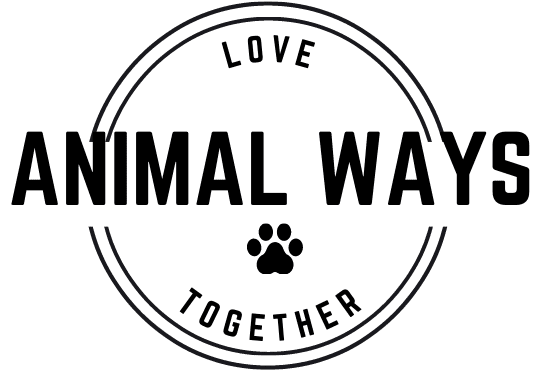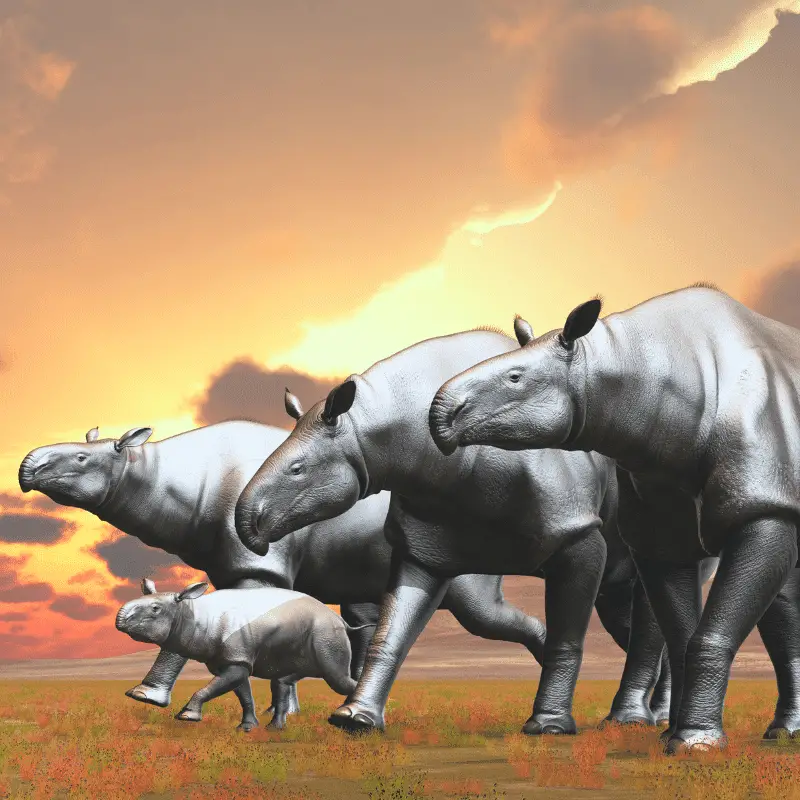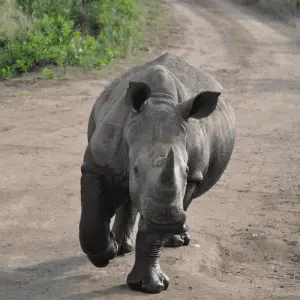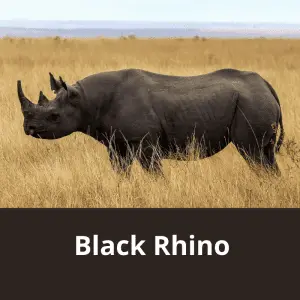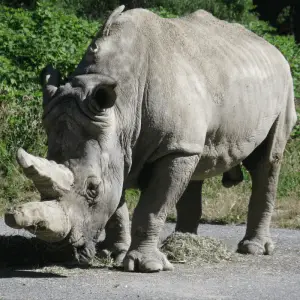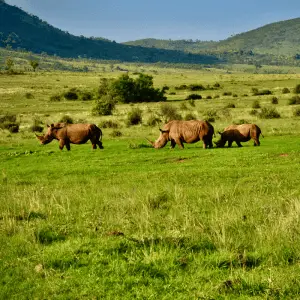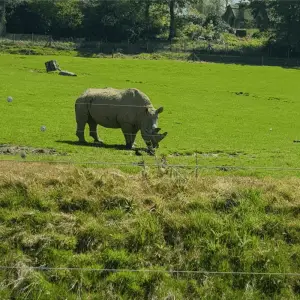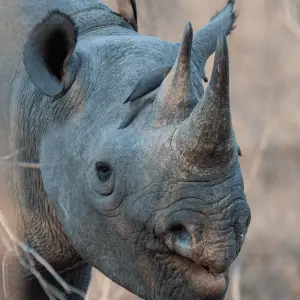The earliest animals with a strong ancestry relationship with modern rhinoceroses are known as paraceratherium. These animals used to roam the earth about 50 million years ago. Not only that, these animals were the giant land animals that have ever walked on the planet. However, the evolution of the rhinoceros did not end with the paraceratherium. Instead, rhinoceroses have continued to evolve for millions of years while facing various environmental obstacles.
Prehistoric Members Of The Rhinoceros Family
Due to the ever-changing environmental obstacles, the rhinos had to overcome them. The below family was the evolution route to today’s rhinos.
Paraceratherium
If you look at the towering image of the paraceratherium, you will find a slight resemblance to the modern rhinoceros. However, the paraceratherium does not have any horns.
These animals lived in the Oligocene epochs and belonged to the superfamily of Rhinocerotoidea.
- Size: 26 Feet Long
- Height: 16 Feet Tall
- Weight: Ten Tons
- Extinct: Yes
Theory Reasons for Extinction
- Climate Change
- Low Reproduction Rate
- Preditors Called Gomphothere
Elasmotherium
Elasmotherium, also known as thin plate-based elasmotherium, was yet another gigantic prehistoric animal with a strong relationship with today’s rhinoceros.
While paraceratherium didn’t have horns, the elasmotherium did, and it is thought to be an enormous horn. However, researchers have yet to discover any fossilised elasmotherium horns. They certainly had horns, as their skull structure shows clearly where their horn would have attached.
The horn size of an elasmotherium is thought to be as big as a metre long.
Unlike most other close relatives of the rhinoceros family, elasmotherium comes with long legs, which enable them to run as fast as a horse.
- Size: 15 Feet Long
- Height: 7 Feet Tall
- Weight: Six Tons
- Extinct: Yes
Theory Reasons for Extinction
- Climate Change, resulting in starvation
Brontotheres
Some of the earliest large mammals belong to this group. Animals belonging to the Megacerop group, which means sizeable horned face animals, walked on the earth about 35 million years ago, weighing about three 3 tons.
Suppose you can guess a modern animal that can fall into this group. In that case, most people will state the rhinoceros, which is correct, as the animals belonging to this group strongly resemble the modern rhinoceros.
Remarkably, another modern animal is also related to this group. Brontotheres belong to the suborder Hippomorpha which also means horses.
The modern rhinoceroses have a strong relationship with the family of horses. That includes zebras, donkeys, and horses. All of these animals are likely ancestry relatives of rhinoceros.
Woolly Rhinoceros
Even though most of the rhinoceroses you see do not have very hairy bodies, their ancestors had lots.
The woolly rhinoceros is one of the ancestors of the modern rhinoceros that got extinct pretty recently. These woolly rhinoceroses first appeared around 4 million years ago and roamed on the earth about 10,000 years ago.
These beasts were almost as big as the modern white rhinoceroses of Africa. These rhinoceroses could reach more than 6 feet tall. The estimated length of the woolly rhinoceros is about 12 feet. However, unlike the white rhinoceros, which is only white in name, not colour, the woolly rhinoceros were covered in thick brown fur.
The woolly rhinoceroses used to live in the frigid Tundra region of modern Northern Europe. These animals have only gone extinct recently, so they are occasionally discovered like frozen mummies.
Almost every frozen mummy has intact skin, hair and other features. You can also spot the woolly rhinoceros in the earliest human cave paintings.
Today, Sumatran rhinoceros are considered the closest relatives of the woolly rhinoceros. Even though these rhinoceroses are not as heavily coated as the woolly rhinoceros, they have retained a substantial amount of fur.
Even until recent times, this was merely a guess, and a recent genetic study has proved that the Sumatran rhinoceros is a direct ancestor of the woolly rhinoceroses.
- Size: 12 Feet Long
- Height: 6 Feet Tall
- Weight: 3.5 Tons
- Extinct: Yes
- Lifespan: 30 Years
Theory Reasons for Extinction
- Climate Change
Teleoceras
Teleoceras had short legs and large bodies and had a close relationship with modern rhinoceroses. Although, I think the teleoceras look more like a hippo than a rhino.
These animals even had teeth structures like the hippopotamuses, and they also were semi-aquatic and spent most of their time wallowing in the streams and lakes. Teleoceras even preferred to feed on land, just like the hippos.
Their short legs indicate that these animals could eat grass and have been primarily found in the South Western and North American regions from about 17 million to 4.5 million years ago.
- Size: 12 Feet Long
- Height: 4 Feet Tall
- Weight: 2 Tons
- Extinct: Yes
Theory Reasons for Extinction
- Climate Change
- Starvation
Cambaytherium
Recently in India, researchers have found the fossils of a creature named Cambaytherium. The exciting finding of this newly discovered fossil is that it showed a strong relationship between the horses and the rhinoceroses.
It’s believed that the Cambaytherium was roaming on the earth between Asia and Madagascar. So how did these animals come to India? It’s thought that these animals migrated onto the Indian Mainland using a land bridge that connected it to the Arabian Peninsula or the horns of Africa.
Once this Bridge disappeared, the animals became isolated, setting up the stage for unique revolutionary conditions for one lineage. Researchers believe that what they see in these fossils is a remnant of the probable ancestral group directly connecting the horses with the modern rhinoceros.
- Size: 3 Feet Long
- Height: 2 Feet Tall
- Weight: 30 kg
- Extinct: Yes
Theory Reasons for Extinction
- Climate Change
- Starvation
